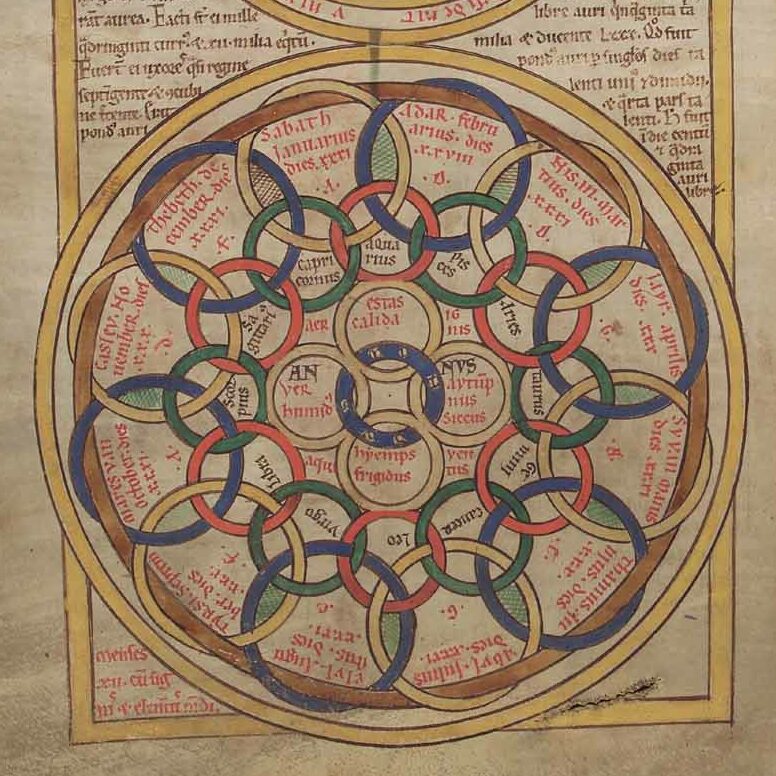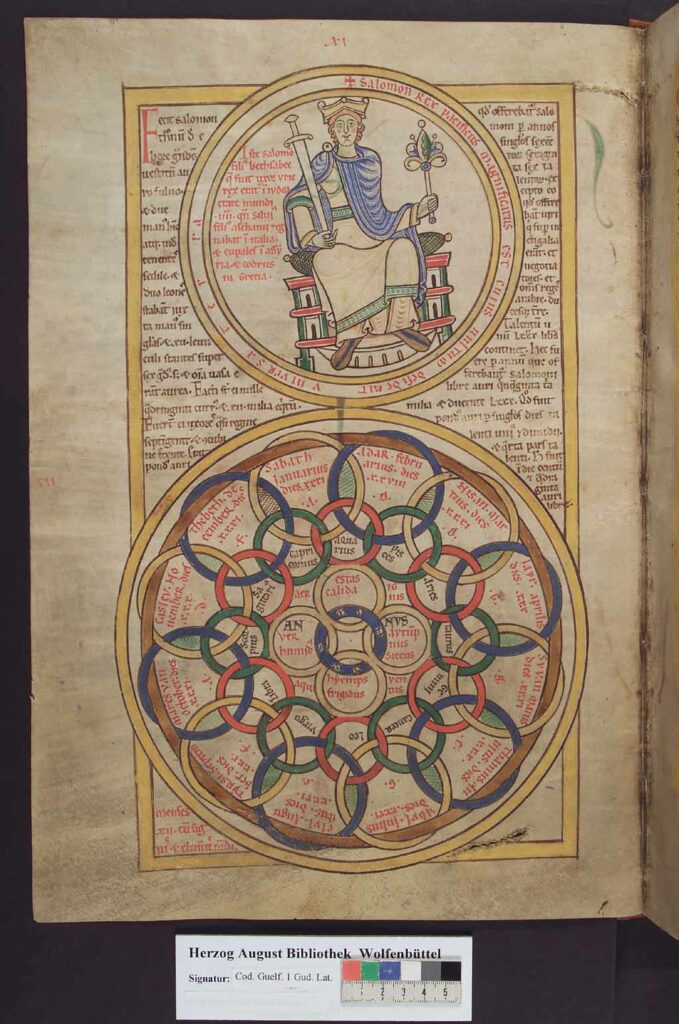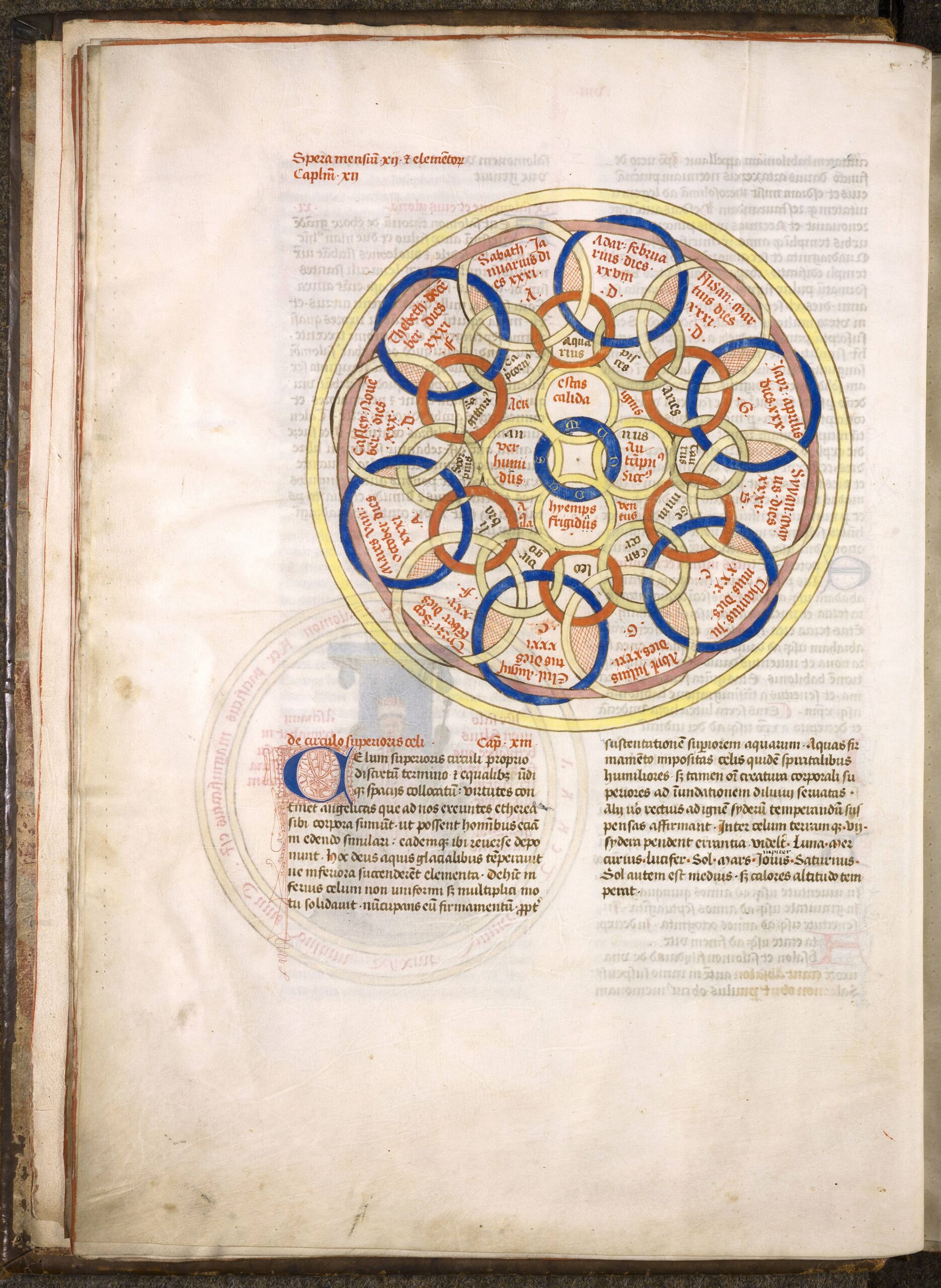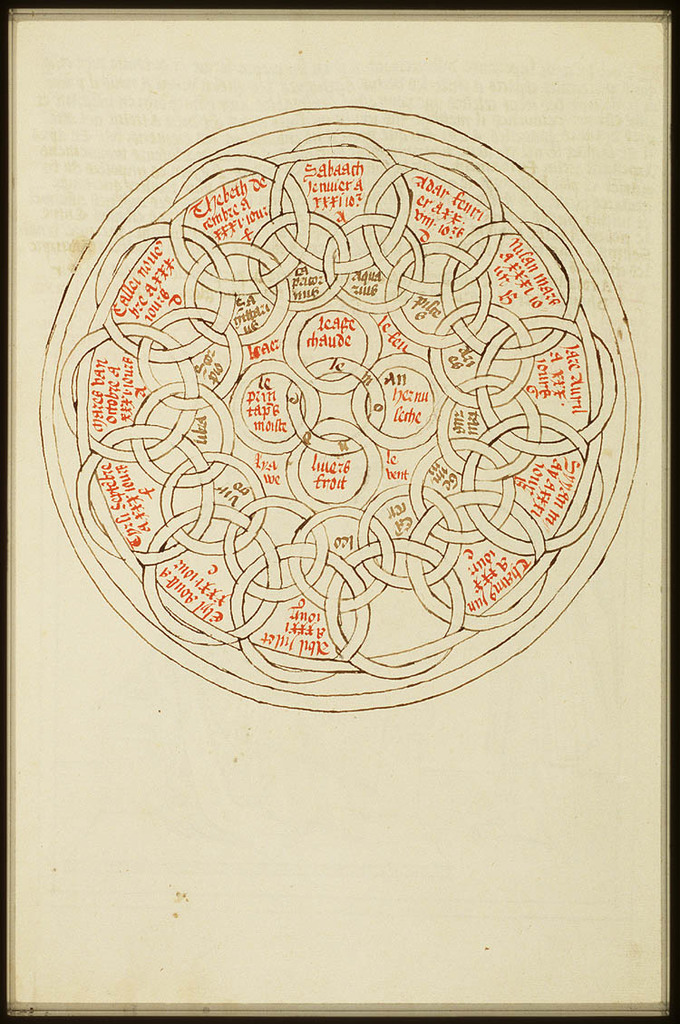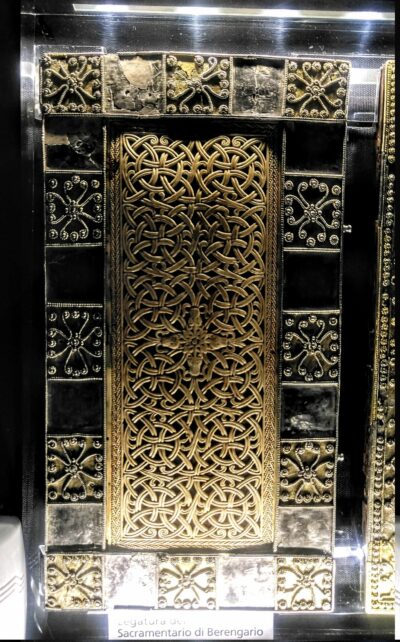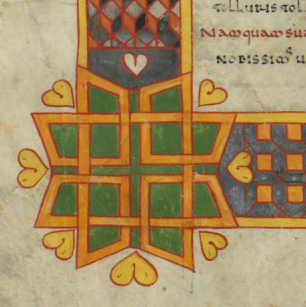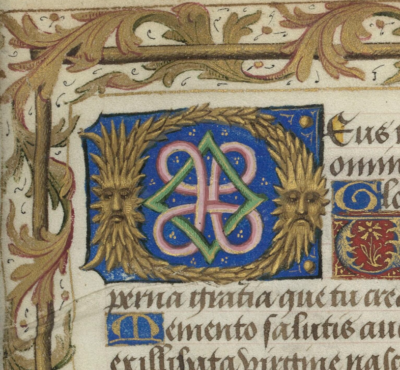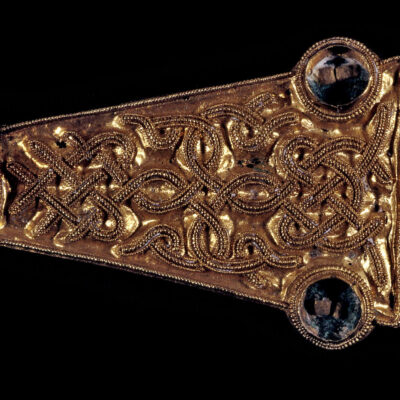The Liber Floridus is an encyclopaedia from ~1120, handwritten and illuminated by Lambert, canon of Notre-Dame de Saint-Omer (Northern France), whose original manuscript is kept at the University of Ghent (Gent), Belgium. This codex exists in 9 known copies, made between the end of the 12th and the beginning of the 16th century.
The illustration we are interested in is found on folio 22 of the Wolfenbüttel manuscript dating from the end of the 12th century, and is absent from the original manuscript of Lambert de Sain-Omer.
It is a circular calendar made up of 28 intertwined circles, including both the 12 months and the 12 signs of the zodiac, the 4 seasons, the 4 elements and the 4 elemental qualities.
Understanding the Liber Floridus calendar
Looking at the calendar from the outside in:
The 12 outer circles, coloured blue and yellow, contain the names of the 12 months of the year in Hebrew and Latin, followed by the number of days in the month (dies XXXI = 31 days) and the dominical letter of the first day of the month.
- January : Sabath • januarius • dies XXXI • A
- February : Adar • febru arius • dies XXVIII • D
- March : Nisan • mar tius • dies XXXI • D
- April : Iayr • aprilis • dies XXX • G
- May : Syvan • maius • dies XXXI • A
- June : Thamus • iunius • dies XXX • ?
- July : Abyl (?) • julius • dies XXXI • G
- August : elyl • augustus • dies XXXI
- September : Tẏrsi • september • dies XXX • F
- October : Maresvan • october • dies XXXI • A
- November : Casley (?) • November • dies XXX • D
- December : Thebeth • december • dies XXXI • F
Note: the dominical letter corresponds to Sunday in a system of notation of the days of the year where the 1st of January is an A, followed by 6 days to which are attributed the letters B, C, D, E, F, G. Then the cycle is repeated throughout the year. This system is notably used to calculate the date of Easter according to the Julian calendar, in use at the time of the creation of the Liber Floridus.
Interlaced with these are 12 smaller red and green interleaved circles. They contain the signs of the zodiac corresponding to each pair of months to which they are attached: Aquarius, Pisces, Aries, Taurus, Gemini, Cancer, Leo, Virgo, Libra, Scorpius, Sagitari, Capricornus.
These are the signs of tropical astrology, which consists of a fixed division of the sun’s course into 12 arcs of 30° beginning with the so-called vernal point. Capricorn, the sign of winter, is attached to the December and January circles.
Then there are 4 words placed between the circles containing the zodiac signs and the following ones. These are the 4 elements: Aer (air), Ignus (fire), Ventus (wind), Aqua (water). Note that here the 4 elements chosen include both Aer and Ventus, but not Terra (earth) as is often the case.
The 4 central golden circles are not interlaced but connected to each others and contain the seasons and the elemental qualities and their elemental qualities. The order is such that each element is placed between the two qualities associated with it it, in the following disposition:
| Aer (air) | Estas (summer) Calida (hot) | Ignis (fire) |
| Ver (spring) Humid’ (humid) | Autūpnus (autumn) Siccus (dry) | |
| Aqua (water) | Hẏemps (winter) Frigidus (cold) | Ventus (wind) |
Seasons are placed in reverse: summer circle is placed on the same side as January and February, while winter is placed under July and August.
Finally, a central blue circle connects these 4 golden circles and has the letters “M U N D U S” all along the circle, which means “the world”, “the universe”, “everything that is” in Latin.
Last detail: in the golden circles of the seasons, we notice the letters “A N” in that of spring (Ver) and “N U S” in that of autumn (Autūpnus). The word annus meaning both “year” and “circle” in Latin.
Other versions of the interlaced calendar
In two later known copies of the Liber Floridus we can also find a take on the circular calendar:
Start of research
A french document helped me to start deciphering and understanding the meaning of each element of this wheel of the year: the Notice sur les manuscrits du “Liber floridus” de Lambert, chanoine de Saint Omer (1906) by Leopold Delisle. On page 44 he describes, in a few lines, the folio of the manuscript containing the calendar. You’ll also find more information in the documentation and sources at the bottom of the page.
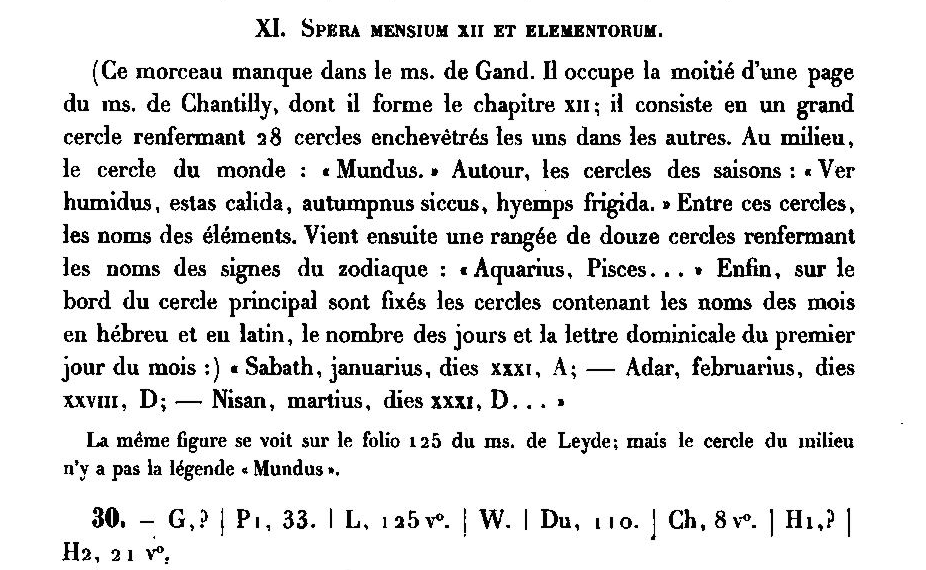
Links & sources
- Site dedicated to the Liber Floridus by Ghent University Library (Universiteitsbibliotheek Gent)
- View the original Liber Floridus manuscript online
- Hebrew calendar (Wikipedia)
- Medieval calendars, Kathleen Doyle and Cristian Ispir, British Library
- How to Read Medieval Handwriting (Paleography), Harvard’s Geoffrey Chaucer Website
List of known Liber Floridus copies in chronological order (source). None of the copies is identical to the original. The circular calendar is missing from the original one.
- Gent, Universiteitsbibliotheek, Lambertus a S. Audomaro. Liber Floridus. Saint-Omer, 1121. View online (source). Ce manuscrit est l’exemplaire original.
- Wolfenbüttel, Herzog Augustbibliothek Ms. Gudeanus lat. 1. Vlaanderen/Henegouwen. Second half twelfth century. View online (source). The interlaced calendar this post is about comes from that manuscript.
- Paris, Bibliothèque nationale de France, Ms. Lat. 8865. Second half thirteenth century. View online (source).
- The Hague, Royal Library, Ms. 27 A 23. Lille/Ninove. 1460. Commissioned by Peter de Goux, Lord of Wedergraete. View online (source).
- Chantilly, Musée Condé, Ms. 724. Gent(?). 3rd quarter fifteenth century. Commissioned by Philip I Conrault, abbot of the Abbey of St. Peter (1444-1471). View online (calendar on folio 8v) (source : Initiale).
- The Hague, Royal Library, Ms. 128 C 4. Edingen. 1512. Commissioned by Philip van Cleef.. View online (calendar on folio 21r) (source : The Hague, KB, 128 C 4).
- Paris, Bibliothèque nationale de France, Ms. Lat. 9675. 1429. View online (source : BNF Latin 9675).
- Douai, Municipal Library, Ms. 796. Second half fifteenth century. (only digitized image)
- Genua, Bibliotheca Durazzo-Giustiniani, Ms. A IX 9. Second half fifteenth century
- Leiden, University Library, Ms. Voss.lat. f. 31, 1-120. 2nd half 13th century. F. 31, f. 121-213. Late thirteenth century. (reference : Universiteit Leiden )
For those who want to further research about the Liber Floridus:
- One of the academic references I wish I could have consulted about the Liber Floridus : Albert Derolez, The making and meaning of the Liber Floridus. A study of the original
manuscript Ghent, University Library MS 92, Londres/Turnhout, éd. Harvey Miller, 2015, 30 cm, 56 p., 22 fig. n. bl., 98 fig. coul., index. – ISBN : 978-1-909400-2-1. (présentation de l’ouvrage dans la revue Médiévales par Nathalie Bouloux https://journals.openedition.org/medievales/10682) - Facsimile of the manuscrit created in 1968 by Albert Derolez for the Ghent University : Lambertus a S. Audomaro, Albert Derolez, and E. I Strubbe. Lamberti S. Audomari Canonici Liber Floridus : Codex Autographus Bibliothecae Universitatis Gandavensis. Gand: Story-Scientia, 1968.
- About that facsimile and the manuscript in itself, read (in french) : Masai François. L’autographe d’une encyclopédie illustrée du XIIe siècle : le «Liber floridus » de l’Université de Gand. In: Scriptorium, Tome 26 n°1, 1972. pp. 80-82.


